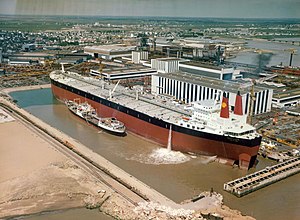 The oil tanker Batillus at the end of her construction in Saint-Nazaire, being fueled. The oil tanker Batillus at the end of her construction in Saint-Nazaire, being fueled.
| |
| Class overview | |
|---|---|
| Name | Batillus class |
| Operators | |
| In service | 1976–2003 |
| Completed | 4 |
| Retired | 4 |
| General characteristics | |
| Type | Supertanker |
| Tonnage | |
| Displacement |
|
| Length | LOA: 414.22 m (1,359.0 ft) LBP: 401.10 m (1,315.9 ft) |
| Beam | 63.01 m (206.7 ft) |
| Draft | 28.5 m (94 ft) |
| Depth | 35.92 m (117.8 ft) |
| Installed power | 64,800 bhp (48.3 MW) |
| Propulsion |
|
| Speed | 16 kn (30 km/h; 18 mph) |
| Notes | |

The Batillus-class supertankers were a class of supertanker ships built in France in the late 1970s, with four ships of this class built between 1976 and 1979. Three of the ships were scrapped after less than ten years of oil transport service each, with the fourth one scrapped in 2003.
All four tankers were built in the Bassin C dock of the Chantiers de l'Atlantique shipyards at Saint Nazaire, France.
History
| This section needs expansion with: who were these ships built for? who paid for them?. You can help by adding to it. (December 2020) |
Vessels in class
- Batillus, built in 1976, scrapped in 1986.
- Bellamya, built in 1976, scrapped in 1986.
- Pierre Guillaumat, built in 1977, scrapped in 1983.
- Prairial, built in 1979, renamed Sea Brilliance, renamed Hellas Fos, renamed Sea Giant, scrapped in 2003.
Measurements
While being the largest ships ever built by gross tonnage until Pioneering Spirit, the four Batillus-class ships were the second largest ever constructed when measuring deadweight tonnage or length overall, behind only the supertanker Seawise Giant (renamed five times, including to Knock Nevis), which existed from 1979 to 2010.
While there were minor differences between the four Batillus-class ships, they all approached a gross tonnage (GT) of 275,000 and 555,000 tonnes deadweight (DWT) tonnage, and had a length overall of over 414 metres (1,358 ft) (longer than all but a few of the tallest skyscrapers in the world).
The Batillus class had a depth of nearly 36 metres (118 ft 1 in) from the main deck and a full load draft of 28.5 metres (93 ft 6 in), the greatest of any vessel, and slightly greater than the two Globtik Tokyo-class Ultra Large Crude Carriers (ULCCs).
Unlike Seawise Giant and most other ULCCs, the Batillus-class vessels had twin propellers, twin boilers of full size and power, and twin rudders. As a result, in the event of an engine or other failure, they could continue operation with the remaining propeller and boiler.
See also
References
- "Batillus". Comoria (in French). Archived from the original on 23 September 2015.
- Clarkson Research Studies Ltd. (1987). Tanker Register 1987. International Publication Service. ISBN 0-8002-4143-6.
- ^ Auke Visser (10 June 2010). "Prairial". International Super Tankers. Retrieved 29 June 2010.
- Auke Visser (10 June 2010). "Batillus". International Super Tankers. Archived from the original on 13 July 2010. Retrieved 29 June 2010.
- Auke Visser (10 June 2010). "Bellamya". International Super Tankers. Retrieved 29 June 2010.
- Auke Visser (10 June 2010). "Pierre Guillaumat". International Super Tankers. Retrieved 29 June 2010.
- Trex, Ethan (1 June 2011). "Seawise Giant: You Can't Keep A Good Ship Down". Retrieved 6 December 2020.
External links
| Batillus-class supertankers | |
|---|---|